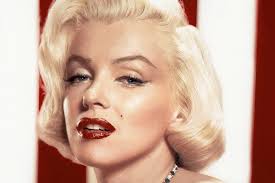
Image courtesy: Art Context
Norma Jeane Mortenson, known to the world as Marilyn Monroe, was born on June 1, 1926, in Los Angeles, California. Monroe’s early years were marked by instability and hardship. Her mother, Gladys Pearl Baker, struggled with mental illness, which led to Monroe spending much of her childhood in foster homes and an orphanage. These challenging experiences undoubtedly shaped her resilience and determination to succeed in the face of adversity.
Despite the difficulties of her early life, Monroe’s natural beauty and charisma were evident from a young age. At 16, she married James Dougherty, a merchant marine, which provided her with a brief period of stability. However, it was during World War II that Monroe’s life began to change dramatically. While her husband was overseas, Monroe worked in a munitions factory, where she caught the eye of photographer David Conover. This chance encounter led to her first modeling job, and soon she was appearing on the covers of popular magazines.
Monroe’s modeling success was a stepping stone to her true passion: acting. In 1946, she signed her first film contract with Twentieth Century Fox, adopting the stage name Marilyn Monroe. Her early roles were minor, but she quickly gained attention for her screen presence and undeniable talent. Films like “The Asphalt Jungle” (1950) and “All About Eve” (1950) showcased her potential, leading to more substantial roles.
By 1953, Monroe had achieved her breakthrough with leading roles in “Niagara,” “Gentlemen Prefer Blondes,” and “How to Marry a Millionaire.” Her performances in these films solidified her status as Hollywood’s newest star. Monroe’s early career was a testament to her perseverance and her ability to captivate audiences, setting the stage for her lasting legacy in the entertainment industry.
Marilyn Monroe’s rise to stardom in the 1950s was nothing short of meteoric. Her unique blend of charm, beauty, and talent quickly garnered the public’s attention, propelling her to become one of Hollywood’s most beloved figures. One of her earliest breakthrough roles was in ‘Gentlemen Prefer Blondes’ (1953), where she portrayed the dazzling showgirl Lorelei Lee. Her performance, especially the iconic rendition of “Diamonds Are a Girl’s Best Friend,” cemented her status as a leading lady in the film industry.
Monroe’s on-screen persona was carefully crafted to embody a blend of innocence and allure, creating a captivating contrast that both intrigued and enchanted audiences. This persona was further solidified with her role in ‘The Seven Year Itch’ (1955), particularly the famous scene where her white dress is blown upwards by a subway grate. This moment became one of the most enduring images of the 20th century, symbolizing Monroe’s lasting impact on popular culture.
Her versatility as an actress was evident in the variety of roles she took on. In ‘Some Like It Hot’ (1959), Monroe showcased her comedic prowess alongside co-stars Tony Curtis and Jack Lemmon. Directed by Billy Wilder, this film is often hailed as one of the greatest comedies of all time, and Monroe’s performance as the vivacious Sugar Kane was a critical component of its success. Her ability to balance humor with vulnerability endeared her to audiences and critics alike.
Monroe’s collaborations with renowned directors such as Howard Hawks and Billy Wilder, as well as her work with co-stars like Jane Russell and Clark Gable, further amplified her influence in the film industry. The public’s fascination with her extended beyond the silver screen, as she became a fashion icon and a symbol of the era’s cultural zeitgeist. Through her memorable performances and unforgettable on-screen presence, Marilyn Monroe left an indelible mark on Hollywood, ensuring her legacy would endure for generations to come.
Marilyn Monroe’s personal life was as complex and multifaceted as her public persona. Born Norma Jeane Mortenson, she faced a turbulent childhood marked by foster care and instability. Monroe’s early marriage to James Dougherty at the age of 16 was a means of escaping this instability. However, their marriage ended in divorce in 1946 as Monroe pursued her acting career.
Her subsequent marriages to baseball legend Joe DiMaggio and playwright Arthur Miller were high-profile and heavily scrutinized by the public. Monroe and DiMaggio’s relationship was passionate yet tumultuous, characterized by intense public interest and personal discord. Their marriage lasted only nine months, though they remained friends until her death. Monroe’s marriage to Arthur Miller, on the other hand, was intellectual and grounded in shared artistic pursuits. Yet, this too ended in divorce, revealing the underlying strains and incompatibilities.
Monroe’s personal relationships extended beyond her marriages. She had numerous friendships within Hollywood, including close bonds with actors like Elizabeth Taylor and Montgomery Clift. These friendships often provided her with the emotional support she lacked elsewhere. However, her personal life was also plagued by challenges, notably her struggles with mental health and substance abuse. Monroe’s battle with depression and anxiety was a stark contrast to her glamorous public image. She frequently sought psychiatric help and was known to have been prescribed various medications, which she occasionally misused.
Substance abuse further complicated her life. Monroe’s reliance on barbiturates and alcohol exacerbated her mental health issues, leading to erratic behavior and professional difficulties. Despite her outward success and iconic status, these personal struggles painted a picture of a woman grappling with profound inner turmoil. The dichotomy between Marilyn Monroe’s public persona and her private battles underscores the complexities of her life, revealing a poignant narrative of vulnerability behind the veneer of stardom.
Marilyn Monroe remains an enduring symbol of beauty and glamour, capturing the imagination of generations long after her untimely death. Her influence on fashion is undeniable; she popularized the “blonde bombshell” look, characterized by platinum blonde hair, red lips, and an hourglass figure. This aesthetic became synonymous with Hollywood’s golden age, setting a standard that continues to inspire designers, makeup artists, and fashion enthusiasts.
Monroe’s impact on popular culture extends beyond her physical appearance. She exemplified the quintessential starlet, blending vulnerability with sensuality in a way that resonated with audiences worldwide. Her performances in films like “Some Like It Hot” and “Gentlemen Prefer Blondes” showcased her comedic timing and acting talent, earning her a place among cinema’s greats. This versatility has made her a subject of admiration and study, cementing her status as a 20th-century icon.
The fascination with Marilyn Monroe’s life and career has been sustained through various forms of media. Numerous books, documentaries, and films have explored different facets of her persona, from her professional achievements to her personal struggles. Exhibitions dedicated to her life, featuring iconic costumes and personal artifacts, draw crowds, further testifying to her lasting appeal. These commemorative efforts ensure that Monroe’s story continues to captivate new audiences.
Monroe’s legacy also permeates the work of subsequent generations of artists and entertainers. Contemporary actresses and musicians often cite her as a source of inspiration, whether emulating her style or channeling her enigmatic presence. Her influence is palpable in the fashion choices of modern celebrities and the thematic elements of various artistic endeavors.
In the realm of cultural icons, few have maintained the lasting impact achieved by Marilyn Monroe. Her life, marked by both triumph and tragedy, continues to influence popular culture, serving as a poignant reminder of the complex interplay between stardom and vulnerability. Through continuous celebration and reinterpretation, Marilyn Monroe remains an indelible figure in the collective consciousness, embodying timeless beauty and enduring allure.
